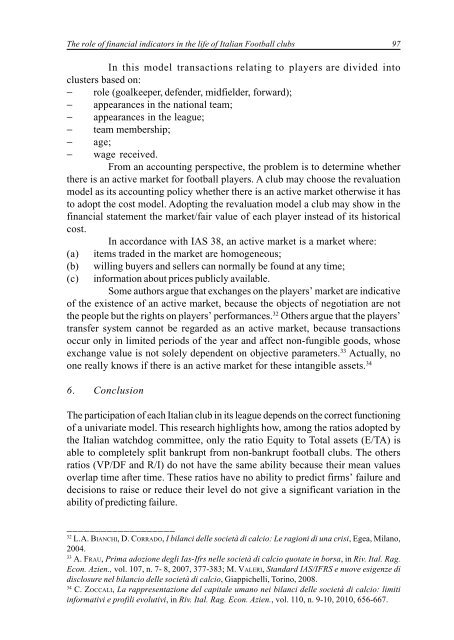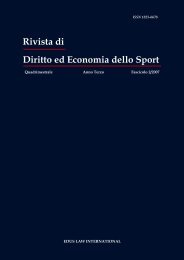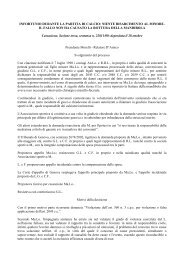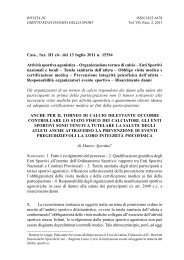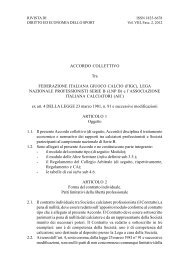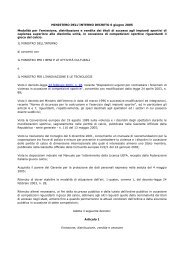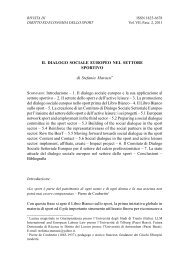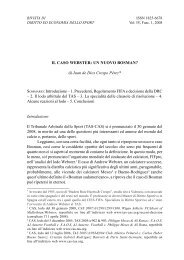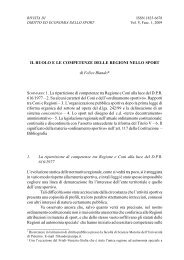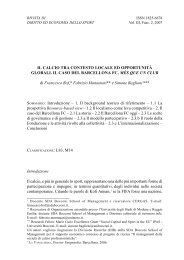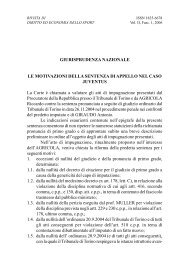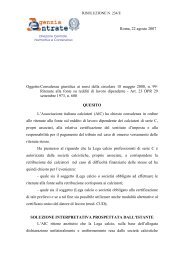Scarica il fascicolo completo - Rdes.It
Scarica il fascicolo completo - Rdes.It
Scarica il fascicolo completo - Rdes.It
You also want an ePaper? Increase the reach of your titles
YUMPU automatically turns print PDFs into web optimized ePapers that Google loves.
The role of financial indicators in the life of <strong>It</strong>alian Football clubs 97<br />
In this model transactions relating to players are divided into<br />
clusters based on:<br />
− role (goalkeeper, defender, midfielder, forward);<br />
− appearances in the national team;<br />
− appearances in the league;<br />
− team membership;<br />
− age;<br />
− wage received.<br />
From an accounting perspective, the problem is to determine whether<br />
there is an active market for football players. A club may choose the revaluation<br />
model as its accounting policy whether there is an active market otherwise it has<br />
to adopt the cost model. Adopting the revaluation model a club may show in the<br />
financial statement the market/fair value of each player instead of its historical<br />
cost.<br />
In accordance with IAS 38, an active market is a market where:<br />
(a) items traded in the market are homogeneous;<br />
(b) w<strong>il</strong>ling buyers and sellers can normally be found at any time;<br />
(c) information about prices publicly ava<strong>il</strong>able.<br />
Some authors argue that exchanges on the players’ market are indicative<br />
of the existence of an active market, because the objects of negotiation are not<br />
the people but the rights on players’ performances. 32 Others argue that the players’<br />
transfer system cannot be regarded as an active market, because transactions<br />
occur only in limited periods of the year and affect non-fungible goods, whose<br />
exchange value is not solely dependent on objective parameters. 33 Actually, no<br />
one really knows if there is an active market for these intangible assets. 34<br />
6. Conclusion<br />
The participation of each <strong>It</strong>alian club in its league depends on the correct functioning<br />
of a univariate model. This research highlights how, among the ratios adopted by<br />
the <strong>It</strong>alian watchdog committee, only the ratio Equity to Total assets (E/TA) is<br />
able to completely split bankrupt from non-bankrupt football clubs. The others<br />
ratios (VP/DF and R/I) do not have the same ab<strong>il</strong>ity because their mean values<br />
overlap time after time. These ratios have no ab<strong>il</strong>ity to predict firms’ fa<strong>il</strong>ure and<br />
decisions to raise or reduce their level do not give a significant variation in the<br />
ab<strong>il</strong>ity of predicting fa<strong>il</strong>ure.<br />
___________________<br />
32 L.A. BIANCHI, D. CORRADO, I b<strong>il</strong>anci delle società di calcio: Le ragioni di una crisi, Egea, M<strong>il</strong>ano,<br />
2004.<br />
33 A. FRAU, Prima adozione degli Ias-Ifrs nelle società di calcio quotate in borsa, in Riv. <strong>It</strong>al. Rag.<br />
Econ. Azien., vol. 107, n. 7- 8, 2007, 377-383; M. VALERI, Standard IAS/IFRS e nuove esigenze di<br />
disclosure nel b<strong>il</strong>ancio delle società di calcio, Giappichelli, Torino, 2008.<br />
34 C. ZOCCALI, La rappresentazione del capitale umano nei b<strong>il</strong>anci delle società di calcio: limiti<br />
informativi e prof<strong>il</strong>i evolutivi, in Riv. <strong>It</strong>al. Rag. Econ. Azien., vol. 110, n. 9-10, 2010, 656-667.


